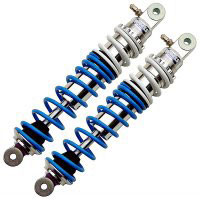
Προϊόντα: 1825 |
Threaded Spring Pre-Load (Tpl). Threaded pre-load (Tpl) is accomplished by turning a threaded collar. As you adjust the threaded collar, which compresses the spring, it will increase the spring pre-load. Increasing Spring Preload moves the spring further into its travel and makes the shock “feel” stiffer initially, and makes the chassis sit a little higher (less sag/more ride height). Spring Pre-load – Pre-load is the distance a spring is compressed, from its free length, to its installed length on the shock (or fork assembly), with the suspension fully extended. The main purpose of spring pre-load is to raise or lower a vehicle’s ride height (sag) by adding tension to the spring. If more than 1/3 of shock travel is eliminated in race or rider sag you need to increase spring preload, or use a stiffer spring. Never add pre-load to prevent chassis roll or intermittent bottoming. Proper springs, spring crossovers and/or sway or torsion bars better handle chassis roll. It is fine to graze or scrape the bottom of the frame once in awhile as long as you are not slamming to the ground, knocking your hands and feet off. Spring Pre-load and Ride Height relationship - By raising or lowering the ride height you are moving a vehicle’s center of gravity, shifting weight balance and changing steering geometry. Optimum ride height is a compromise between the lowest level possible (lowest center of gravity to improve cornering stability), having enough chassis clearance (to prevent the frame or pegs from continuously hitting the ground), moving the weight balance forward or back (more weight on front tire = more traction for turn) and having enough trail (to prevent understeer/oversteer in cornering and improve front wheel self-center). Adjusting pre-load to the proper sag dimension is one of several factors to insure traction as wheel load gets light and drops into bumpy holed sections of terrain (See also damping). Spring Pre-load and spring rate - CHANGING PRE-LOAD DOES NOT CHANGE SPRING RATE. You don’t get a stiffer spring by adding pre-load. Rather you change the weight point at which the spring starts to move. Once the spring starts to compress it will move at its spring rating.
Methods of Preload Adjustment - In addition to the threaded collar, other methods of adjustment are pre-load shims or pre-load spacers. On a fork spring kit, this is typically an internal spacer.
|
|||||||||||||||||||||






















































